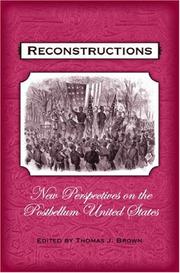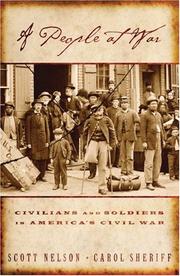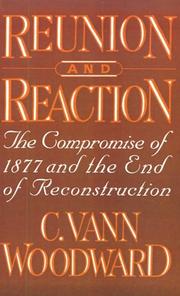| Listing 1 - 10 of 68 | << page >> |
Sort by
|
Book
ISBN: 1469628082 9781469628080 9781469626253 146962625X 9781469626246 1469626241 9798890848161 Year: 2016 Publisher: Chapel Hill
Abstract | Keywords | Export | Availability | Bookmark
 Loading...
Loading...Choose an application
- Reference Manager
- EndNote
- RefWorks (Direct export to RefWorks)
"Nash analyzes the unfolding of Reconstruction in the mountain counties of southern Appalachia, focusing on the particular ways that region's patterns of development, relatively low levels of prewar slaveholding, political allegiances, histories of violence, etc., shaped the era politically and socially. Nash chronicles the region's political transformation, first as a new politics predicated on wartime loyalty rose in place of the prewar partisan system. He argues this first transition was followed by a further transformation as anti-Confederates relied on the federal government (mostly in the form of the Freedmen's Bureau) to establish a coherent party and platform in the region. Finally, Nash shows how the Conservative resurgence toppled this new regime, with conservatives aggressively courting new economic development schemes in order to connect the region into the burgeoning national markets"--
Book
ISBN: 9781469638249 146963824X 9781469638225 1469638223 Year: 2017 Publisher: [Boone, N.C.] Appalachian State University
Abstract | Keywords | Export | Availability | Bookmark
 Loading...
Loading...Choose an application
- Reference Manager
- EndNote
- RefWorks (Direct export to RefWorks)

ISBN: 0190291915 0199723974 9786611826055 1281826057 1281156566 9786611156565 019803914X 1429468866 9780199723973 9780198039143 9780195175950 0195175956 0195175956 9780195383065 0197715745 Year: 2006 Publisher: Oxford ; New York : Oxford University Press,
Abstract | Keywords | Export | Availability | Bookmark
 Loading...
Loading...Choose an application
- Reference Manager
- EndNote
- RefWorks (Direct export to RefWorks)
This text surveys scholarship on Reconstruction and identifies directions for future research. It shows that the issues in interpretive debates have changed, but that Reconstruction inspires historical literature and encompasses a range of adjustments to the effects of the Civil War.

ISBN: 1281975532 9786611975531 0199725977 9780199725977 9781281975539 0195146549 9780195146547 0195146557 9780195146554 0199881944 0197715346 Year: 2007 Publisher: New York : Oxford University Press,
Abstract | Keywords | Export | Availability | Bookmark
 Loading...
Loading...Choose an application
- Reference Manager
- EndNote
- RefWorks (Direct export to RefWorks)
Introduction: A People at War. FROM COMPROMISE TO CHAOS: 1854-1861. 1. The Road to Bleeding Kansas. 2. From Wigwam to War. THE CHANGING FACES OF WAR: 1861-1863. 3. Friends and Foes: Early Recruits and Freedom's Cause, 1861-1862. 4. Union Occupation and Guerilla Warfare. 5. Facing Death. POLITICAL, MILITARY, AND DILPOMATIC REMEDIES: 1862-1865. 6. Two Governments Go to War: Southern Democracy and Northern Republicanism. 7. Redefining the Rules of War: The Lieber Code. 8. Diplomacy in the Shadows: Cannons, Sailors, and Spies. THE WAR HITS HOME: 1861-1865. 9. We Need Men: Union Struggles over Manp
Reconstruction (U.S. history, 1865-1877) --- Carpetbag rule (U.S. history, 1865-1877) --- Reconstruction (1865-1877) --- Postwar reconstruction --- United States --- History --- Social aspects. --- Influence. --- Politics and government
Book
ISBN: 0817385983 9780817385989 9780817317454 0817317457 Year: 2012 Publisher: Tuscaloosa University of Alabama Press
Abstract | Keywords | Export | Availability | Bookmark
 Loading...
Loading...Choose an application
- Reference Manager
- EndNote
- RefWorks (Direct export to RefWorks)
The Jackson County War offers original conclusions explaining why Jackson County became the bloodiest region in Reconstruction Florida and is the first book-length treatment of the subject. From early 1869 through the end of 1871, citizens of Jackson County, Florida, slaughtered their neighbors by the score. The nearly threeyear frenzy of bloodshed became known as the Jackson County War. The killings, close to one hundred and by some estimates twice that number, brought Jackson County the notoriety of being the most violent county in Florida during the

ISBN: 1423726383 1280524936 1601297718 0199727856 9781423726388 9781601297716 9780195064230 0195064232 9781280524936 9786610524938 6610524939 0195064232 9780199727858 0197715869 Year: 1991 Publisher: New York ; Oxford : Oxford University Press,
Abstract | Keywords | Export | Availability | Bookmark
 Loading...
Loading...Choose an application
- Reference Manager
- EndNote
- RefWorks (Direct export to RefWorks)
First published in 1951, this historical textbook has been reissued with a new introduction by the author. It discusses the American Reconstruction period, the history of the US Republican Party and the realignment of forces that fought the American Civil War.
Book
ISBN: 9781400863563 1400863562 0691630194 0691600244 Year: 2014 Publisher: Princeton Princeton University Press
Abstract | Keywords | Export | Availability | Bookmark
 Loading...
Loading...Choose an application
- Reference Manager
- EndNote
- RefWorks (Direct export to RefWorks)
At stage center of the American drama, maintains David A. J. Richards, is the attempt to understand the implications of the Reconstruction Amendments--Amendments Thirteen, Fourteen, and Fifteen to the United States Constitution. Richards evaluates previous efforts to interpret the amendments and then proposes his own view: together the amendments embodied a self-conscious rebirth of America's revolutionary, rights-based constitutionalism. Building on an approach to constitutional law developed in his Toleration and the Constitution and Foundations of American Constitutionalism, Richards links history, law, and political theory. In Conscience and the Constitution, this method leads from an analysis of the Reconstruction Amendments to a broad discussion of the American constitutional system as a whole.Richards's interpretation focuses on the abolitionists and their radical commitment to the "dissenting conscience." In his view, the Reconstruction Amendments expressed not only the constitutional arguments of a particular historical period but also a general political theory developed by the abolitionists, who restructured the American political community in terms of respect for universal human rights. He argues further that the amendments make a claim on our generation to keep faith with the vision of the "founders of 1865." In specific terms he points out what such allegiance would mean in the context of present-day constitutional issues.Originally published in 1993.The Princeton Legacy Library uses the latest print-on-demand technology to again make available previously out-of-print books from the distinguished backlist of Princeton University Press. These editions preserve the original texts of these important books while presenting them in durable paperback and hardcover editions. The goal of the Princeton Legacy Library is to vastly increase access to the rich scholarly heritage found in the thousands of books published by Princeton University Press since its founding in 1905.
Reconstruction (U.S. history, 1865-1877) --- Abolitionists --- Civil rights --- Carpetbag rule (U.S. history, 1865-1877) --- Reconstruction (1865-1877) --- Postwar reconstruction --- History. --- United States.
Book
ISBN: 9780817390679 0817390677 9780817319335 0817319336 0817360557 Year: 2016 Publisher: Tuscaloosa, Alabama
Abstract | Keywords | Export | Availability | Bookmark
 Loading...
Loading...Choose an application
- Reference Manager
- EndNote
- RefWorks (Direct export to RefWorks)
Civil rights --- Reconstruction (U.S. history, 1865-1877) --- Carpetbag rule (U.S. history, 1865-1877) --- Reconstruction (1865-1877) --- Postwar reconstruction --- History. --- Southern States --- History
Book
ISBN: 0190865695 0190865717 0190865709 9780190865702 9780190865719 9780190865696 Year: 2018 Publisher: New York, NY
Abstract | Keywords | Export | Availability | Bookmark
 Loading...
Loading...Choose an application
- Reference Manager
- EndNote
- RefWorks (Direct export to RefWorks)
"This concise history delves into the constitutional, political, and social issues behind Reconstruction to provide a lucid and original account of a historical moment that left an indelible mark on American social fabric. [The author] depicts Reconstruction as a "bourgeois revolution" -- as the attempted extension of the free-labor ideology embodied by Lincoln and the Republican Party to what was perceived as a Southern region gone awry from the Founders' intention in the pursuit of Romantic aristocracy"--
Book
ISBN: 0813022479 9780813022475 Year: 1999 Publisher: Gainesville, FL : University Press of Florida,
Abstract | Keywords | Export | Availability | Bookmark
 Loading...
Loading...Choose an application
- Reference Manager
- EndNote
- RefWorks (Direct export to RefWorks)
| Listing 1 - 10 of 68 | << page >> |
Sort by
|

 Search
Search Feedback
Feedback About UniCat
About UniCat  Help
Help News
News